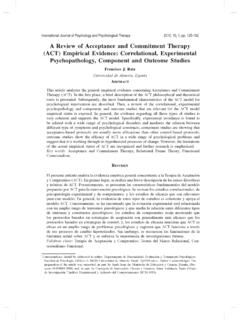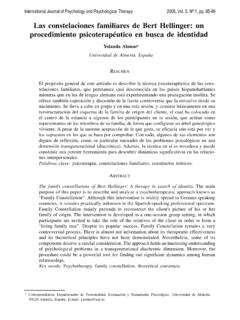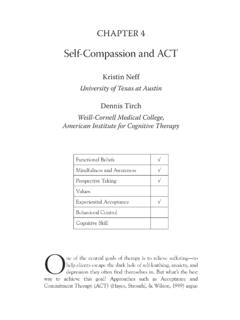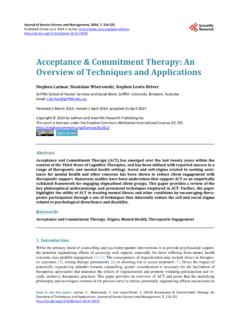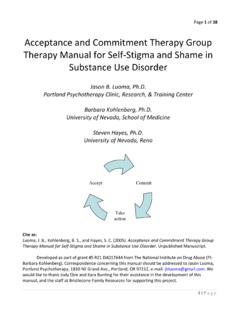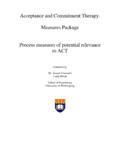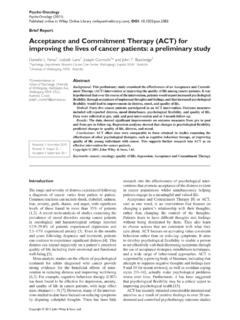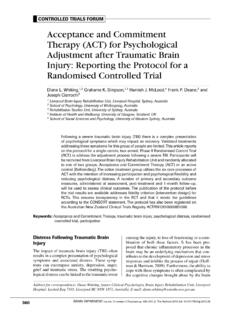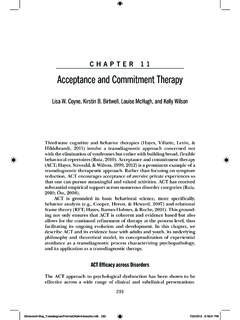Transcription of A Review of Acceptance and Commitment Therapy …
1 International Journal of Psychology & Psychological Therapy , 12, 3, 359-372, 2012 Printed in Spain. All rights reserved. Copyright 2012 AAC A Review of Acceptance and Commitment Therapy with Anxiety DisordersKatie SharpThe University of Kansas, USA*Address correspondence to: 496 Hutton Circle, Lawrence, KS 66049, USA. Email: disorders are the most widespread cause of distress among individuals seeking treatment from mental health services in the United States. However, despite the prevalence of research on effective therapeutic interventions and their promising outcomes, significant shortcomings remain. In response to these drawbacks, a novel treatment, Acceptance and Commitment Therapy (ACT), was developed in an attempt to reformulate the conceptualization and treatment of anxiety disorders. The new treatment takes advantage of the power of exposure therapies while simultaneously addressing issues of comorbidity, fear, and avoidance related to them, as well as emphasizing the Commitment to clients chosen values.
2 Although the research base is small, a Review of the current literature supports the notion that the ACT model of anxiety may be appropriate for conceptualizing and subsequently treating these words: Acceptance and Commitment Therapy , anxiety disorders. With a one-year prevalence rate of for adults aged 18-54 (Narrow, Rae, Robins, & Regier, 2002), anxiety disorders are the most widespread cause of distress among individuals seeking treatment from mental health services in the United States (Orsillo, Roemer, Block-Lerner, LeJeune, & Herbert, 2005). Furthermore, they are often chronic afflictions. The three-year remission rates for social phobia, generalized anxiety disorder, agoraphobia, and panic disorder with agoraphobia ranges anywhere from 16 to 23% (Keller, 2000). Additionally, anxiety disorders often cause their sufferers a great deal of functional impairment, as they are correlated with higher rates of financial dependence, unemployment (Leon, Portera, & Weissman, 1995), poorer quality of life (Massion, Warshaw, & Keller, 1993), and an increased risk for suicide (Allgulander, 1994).
3 Due to the prevalence, chronicity, and cost associated with anxiety disorders, it is not surprising that tremendous effort has gone into developing effective treatments, and there is reason to be optimistic about the gains made from this line of research. For instance, cognitive-behavioral treatment for panic disorder yields large effect sizes, ranging from .68 to .88 (Gould, Otto, & Pollack, 1995), and a large percentage of these patients will remain panic free one year later (Barlow, 2002). Cognitive-behavioral 360 InternatIonal Journal of Psychology & PsychologIcal Therapy , 2012, 12, 3 http://www. ijpsy. comSharptherapies have also demonstrated their effectiveness in treating obsessive-compulsive disorder (OCD; Abramowitz, 1997) and generalized anxiety disorder (GAD; Borkovec & Ruscio, 2001).
4 Research also suggests that exposure treatments for social anxiety disorder yield large effect sizes when used as interventions in themselves (.89) or in combination with cognitive restructuring (.80; Gould, Buckminster, Pollack, Otto, & Yap, 1997). Despite the prevalence of research on effective therapeutic interventions and promising outcomes in the treatment of anxiety disorders, significant shortcomings remain. For example, even when clients are provided with empirically supported treatment protocols, a significant number fail to respond to treatment, and of those who do demonstrate measurable improvement, many still remain functionally impaired and will continue to seek treatment (Orsillo et al., 2005). This is particularly true for clients presenting with more severe anxiety disorders or those with co-morbid conditions (Barlow, 2002).
5 In addition, many clients will find exposure Therapy intolerable and prematurely end treatment (Orsillo et al., 2005). In response to these drawbacks, a novel treatment, Acceptance and Commitment Therapy (ACT; Hayes, Strosahl, & Wilson, 1999), was developed in attempt to reformulate the conceptualization and treatment of anxiety disorders. The new treatment takes advantage of the power of exposure therapies while simultaneously addressing issues of comorbidity, fear, and avoidance related to them. It also adds an emphasis on the Commitment to clients chosen values (Orsillo et al., 2005). Furthermore, one study suggests that therapists with little training get better results when using ACT than CBT (Lappalainen, Lehtonen, Skarp, Taubert, Ojanen, & Hayes, 2007).WhAt is Acceptance And Commitment Therapy ? An overvieWAcceptance and Commitment Therapy is a third-wave behavior Therapy rooted in the philosophical tradition of functional contextualism (Hayes, Hayes, Reese, & Sarbin, 1993) and based on Relational Frame Theory (Hayes, Barnes-Holmes, & Roche, 2001).
6 ACT has two major goals: (a) actively accepting unwanted and perhaps uncontrollable thoughts and feelings and (b) Commitment and action towards goals that are aligned with one s chosen values. Thus, ACT is about Acceptance and change at the same time (Eifert & Forsyth, 2005). ACT is predicated on the notion that psychological suffering is caused by cognitive entanglement ( , fusion with maladaptive thoughts), psychological rigidity that prevents individuals from taking action towards their values, and experiential avoidance (behaviors that are intended to alter the intensity or frequency of unwanted private experiences such as unpleasant thoughts, feelings, and bodily sensations; Hayes et al., 1999). Six core processes of ACT are used to increase psychological flexibility. These include, - Cognitive defusion: strategies to reduce the reification of thoughts, sensations, and emotions; - Acceptance : allowing experiences to be as they are without resistance; http://www.
7 Ijpsy. com InternatIonal Journal of Psychology & PsychologIcal Therapy , 2012, 12, 3act with anxiety DiSorDerS361- Contact with the present moment: being open, interested, and receptive to the here and now; - Self as context: developing a concrete sense of self as observer that is stable and independent of the changing experiences of each moment; - Values: defining what is most important in a person s life; and - Committed action: taking actions that are guided by one s values. When applied towards anxiety disorders, ACT teaches clients to end the struggle with the unpleasant sensations stemming from their anxiety while simultaneously choosing behaviors that move them closer to their values -regardless of what unpleasant thoughts and feelings these actions may spawn (Twohig, Masuda, Varra, & Hayes, 2005).
8 General reviews of the effectiveness of ACT have included anxiety together with other conditions (Pull, 2008; Ruiz, 2010; Hayes, Luoma, Bond, Masuda, & Lillis, 2006; Ost, 2008). One other Review has examined the use of ACT with anxiety disorders in isolation (Soo, Tate, & Lane-Brown, 2011); however, several contributive studies were missing from that paper. Thus, this Review contributes to the burgeoning ACT research base by focusing specifically and more comprehensively on the use of ACT and its key elements with anxiety for Anxiety disorders: A rAtionAle Evidence supports the notion that anxiety disorders are developed and maintained by avoidant behavior patterns and fusion with maladaptive thoughts (Orsillo et al., 2005). Research also supports the notion that attempts to regulate anxiety may increase psychological suffering and transform experiences of anxiety into a maladaptive form (Hayes et al.)
9 , 1999). The ACT approach is well equipped to address these concerns because it teaches clients how to accept and live with unpleasant symptoms of anxiety ( , worries, bodily sensations, disturbing thoughts, etc.) rather than trying to eliminate or suppress them (Hayes et al., 1999). Thus, ACT fosters a willingness to be with all of human experience, which increases psychological flexibility and reduces attempts to avoid psychological and emotional phenomena. Clients are then free to choose actions that lead them closer to their chosen is based on the idea that experiential avoidance can be linked to the processes of language. For example, language creates rule-governed patterns of behavior ( , I will be anxious at the party so I won t go ) as well as negative self-evaluations ( , I am incompetent ).
10 Individuals often become entangled in the web of judgments and negative evaluations, which substantially impacts their life choices. For example, clients may wish to engage in a social event with their significant other or friends as part of enjoying a valued life, but their avoidance behavior tends to dominate (Eifert et al., 2009), so they choose to stay home. Thus, defusion from the literality of thoughts is a primary focus in sum, the ACT formulation of anxiety disorders conceptualizes the problems arising from anxiety as stemming from 6 conditions: (a) clients are unwilling to experience 362 InternatIonal Journal of Psychology & PsychologIcal Therapy , 2012, 12, 3 http://www. ijpsy. comSharpthe physiological concomitants of anxiety ( , shaking, sweating, etc.)
